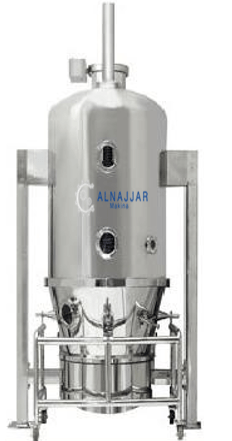Fluid Bed Processing involves fast drying, cooling and agglomeration of particulate materials.It is ideal for heat sensitive and non heat sensitive products in Pharmaceuticals.
A Fluid Bed Dryer (FBD) is a type of equipment widely used in the pharmaceutical, chemical, food, and other industries for drying and granulation processes. It operates on the principle of fluidization, where air is passed through a bed of solid particles, creating a fluidized state.
- Here are key aspects of the Fluid Bed Dryer:
1. Principle of Operation:
- The fluid bed dryer operates based on the principle of fluidization. In this process, a stream of air is passed through a porous bed of solid particles, causing them to behave like a fluid. This fluidized state enhances heat and mass transfer, making it an efficient method for drying and granulating.
2. Components:
- The main components of an FBD typically include a product container, a perforated plate (for air distribution), an air supply system, a filter for dust collection, and a fan for air circulation.
3. Drying and Granulation:
- FBDs are versatile and can be used for both drying and granulation processes. In the drying mode, wet particles are fluidized and dried by the passing hot air. In the granulation mode, the process involves spraying a liquid binder onto the fluidized particles, leading to the formation of granules.
4. Controlled Temperature and Airflow:
- FBDs allow for precise control over temperature and airflow. This control is crucial to ensure optimal drying conditions and to prevent over-drying or overheating of sensitive products.
5. Uniform Drying:
- The fluidization process ensures uniform drying or granulation. Each particle in the fluidized bed is exposed to the same drying conditions, resulting in a homogenous product.
6. Rapid Drying Rates:
- Due to the intimate contact between the fluidized particles and the drying air, FBDs can achieve rapid drying rates, making them time-efficient for large-scale production.
7. Batch and Continuous Processing:
- FBDs are available in both batch and continuous processing configurations. Batch processing is suitable for smaller quantities and frequent product changes, while continuous processing is more efficient for large-scale and continuous production.
8. Coating Applications:
- In addition to drying and granulation, FBDs are also used for coating applications. Coating involves applying a thin layer of a coating material onto the surface of particles, providing functionalities such as taste masking, controlled release, or improved stability.
9. Pharmaceutical Applications:
- In the pharmaceutical industry, FBDs are commonly used for drying wet granules obtained from high-shear granulators or for coating tablets with a protective or functional coating.
10. CIP (Clean-In-Place) Systems: – Many modern FBDs are equipped with Clean-In-Place systems to facilitate easy and efficient cleaning between batches, ensuring compliance with hygiene and GMP (Good Manufacturing Practice) standards.
In summary, Fluid Bed Dryers are versatile pieces of equipment utilized for drying, granulation, and coating processes in various industries, with a particular emphasis on pharmaceutical manufacturing. They offer advantages such as uniformity, efficiency, and flexibility in processing different materials.


